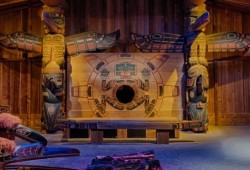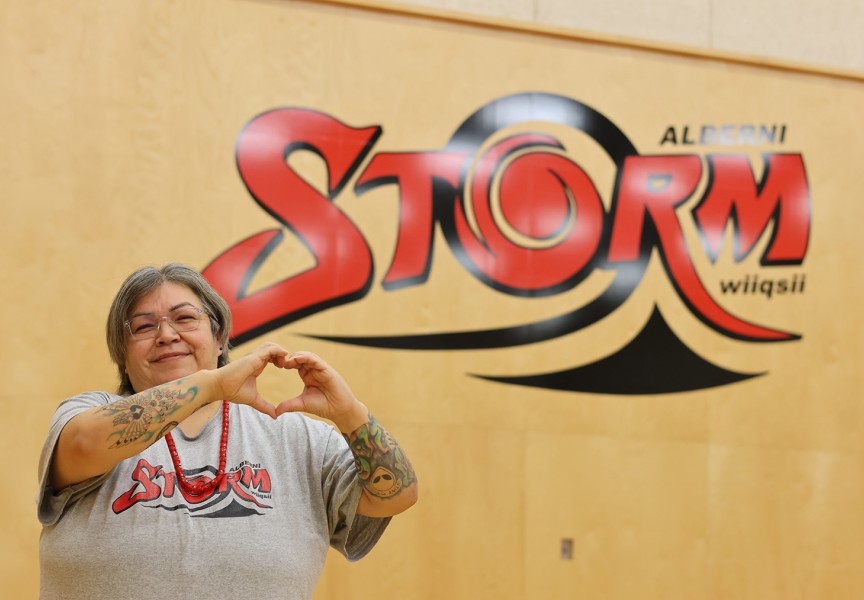It’s been just over two years since the Royal BC Museum closed its third-floor galleries to the public so that it could begin the process of decolonization of the exhibits. The floor is home to the First People’s Gallery, the Our Living Languages – First People’s Gallery and Becoming B.C., also known as the Old Town Gallery.
According to RBCM website information, when the First Peoples Gallery opened in 1977, First Nations works were usually classed as anthropological artifacts or examples of material culture rather than as art. First created in the 1960s and ‘70s, the third-floor galleries were due for much-needed updates.
Today it offers the works of both past and present Indigenous artists, with updated contextual information.
The popular Old Town exhibit was updated and reopened in July 2023. Then on April 2 the museum announced the reopening of the two exhibits in the First Peoples Gallery to visitors. The First Peoples Gallery reopened the Our Living Languages exhibit and RBCM is excited to announce the opening of the Jonathan Hunt House. Both installations were created in collaboration with First Nations.
“The museum is honoured to once again open the doors to Jonathan Hunt House and Our Living Languages,” says Tracey Drake, CEO of the Royal BC Museum. “These spaces on the museum’s third floor share important Indigenous stories and this work is a reflection of the museum’s continued commitment to the Declaration on the Rights of Indigenous Peoples Act by delivering unique experiences for British Columbians.”
The Jonathan Hunt House is a ceremonial piece and museum installation that allows visitors to enter a re-creation of the house of Chief Kwakwabalasami, the late Jonathan Hunt, a Kwakwaka’wakw chief who was born and lived his life in the community of Tsaxis, near Fort Rupert, B.C.
The exhibit has been updated with the help and guidance of master carver and artist Richard Hunt, Jonathan Hunt’s grandson, who helped his father with the original installation in 1977.
“[I]n the potlatch system, the chief formally presents, to an invited audience, crest images, songs, names, and other prerogatives to which he claims inherited rights,” states information from the museum. “The audience’s recognition of the chief’s claim is its legal validation. Jonathan Hunt potlatched twice for this house, once at Victoria and once at Alert Bay, and spent thousands of dollars in the appropriate manner to confirm his right to display the house and its images. An arrangement between Jonathan Hunt, his descendants and the Royal BC Museum allows the museum to exhibit the house permanently, while cultural ownership of the house and its images remains in the Hunt family.”
Also featured at RBCM is Totem Hall, the central exhibit in the First Peoples Gallery. Visitors will see towering carved poles from around the province, including Nuu-chah-nulth works such as Numnuquamis from the Sarita River in Barkley Sound.
Nuu-chah-nulth carving and art is included in other displays on the third floor, along with the works of other First Nations.
Our Living Languages is another important and more recent exhibit that has been updated and reopened.
According to RBCM, Our Living Languages was developed in partnership with the First Peoples’ Cultural Council.
“It shares the history of First Nations languages in B.C., the beauty and complexity of these languages, and the people working tirelessly to document and revitalize them,” stated the museum.
First opened to the public in 2014, Our Living Languages is an interactive gallery that allows the visitor to hear fluent speakers over headphones. Its content relies on the important work of digitizing old recordings of B.C.’s Indigenous people speaking their languages. Work that continues to this day, thanks to generous contributions of donors.
In 2017 Ha-Shilth-Sa reported that the TD Bank Group contributed $50,000 to support the Royal BC Museum’s First Nations Language Revitalization Project as it works to digitize and preserve hundreds of cassette tapes containing Indigenous languages for future generations.
The Royal BC Museum has more than 4,000 tapes to be digitized. A notable contribution to the collection is the 171 cassette tapes from Tseshaht elders, the late Doug and Kathy Robinson.
On April 16 the Royal BC Museum was pleased to announce that it received $250,000 from the Wesik Family Foundation to continue their work on the Indigenous Audio-Visual Collection Digitization Project.
“This generous donation from the Wesik Family Foundation will support the digitization and preservation of language and cultural traditions of more than 200 Indigenous communities and nations located throughout British Columbia.” said Drake. “Digitizing the audio-visual collection ensures long-term care and sharing of significant cultural knowledge and voices. We are extremely grateful to the Wesik Family Foundation for their financial support to advance this important work.”
The Indigenous Audi-Visual Collection consists of more than 28,000 individual photos, audio recordings and moving images (videos) taken across British Columbia from 1890 to 1990 through provincial linguistic and anthropological research.
Currently, only 20 per cent of the collection has been digitized and the Wesik Family Foundation donation will contribute to preserving the remaining 80 per cent. The project will also facilitate the transferring of cultural knowledge back to the First Nations and Indigenous communities.









